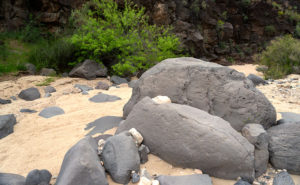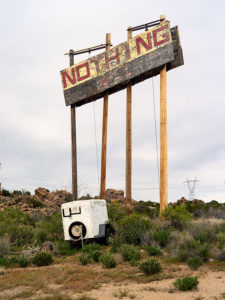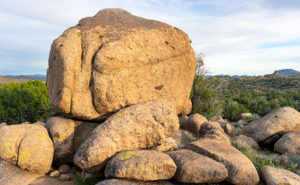The Sonoran Desert is at its best in April, when spring drags everything back to life. The cactus bloom, mesquite trees put out new leaves, palo verde trees turn yellow, the animals are horny, and there are dead snakes all over the highway. Each year we don’t have to run the air conditioning or the heater for two months. We manage the house temperature by strategically opening or closing the windows during the day. But, along with the beauty and rebirth, we dread the coming heat with being stuck indoors and up to our eyeballs in power company debt. It’s like having sex and then a kid.
Arizona has always been hot—well, maybe except for the millions of years when it was a sea bed, but that was a fleeting moment. Not all the heat was from the weather. Our state is a hot spot for volcanic activity. We have over 600 sites of volcanic mountains, cinder cones, shield volcanoes, lava flows, and lava fields. Our two tallest mountains—Mt. Humphries in the San Francisco Peaks and Mt. Baldy in the White Mountains—are volcanoes that spewed ash, cinders, and pyroclastic flows at the same time (talk about dual exhaust). Not all the activity is ancient history. The most recent eruption was about a thousand years ago, and it’s not over yet. Geologists say there’s a 13% chance that another outbreak will happen in the next millennium.
As a photographer, all of these bumps, cracks, warts, and irregularities are what makes Arizona such a remarkable subject for pictures. I’m sure the millions of people who come and stand at the edge of our big ditch in the north would agree. So, what does all this have to do with my self-assigned Nothing project? I’m glad you asked.
As you travel north from the Nothing pass, Highway US 93 makes a downhill run to the bridges at Burro Creek, and on each side of the road is a small lava field that doesn’t have a name (according to my references). It must be ancient because it has enough vegetation that blends with the surrounding landscape. Along the flow’s southwest border, there is a spring and wash that carved a ravine through the lava bed called Black Canyon. It was this landmark that Fred and I set off to explore last week before getting distracted by George’s Camp—ooh, squirrel.
Black Canyon is easy to find from George’s because its mouth is next to the property—across the street if you will. Within a few steps, we began hiking up a wash that had cut through the dark basalt lava. As we continued, the walls grew higher, and big, water-polished basalt boulders littered the oatmeal colored sand. Their smooth surface contrasted with the rectangular blocks making up the canyon sides. Even though we walked in deep dry sand, it was clear that a lot of water must flow along the course. When wet, the dark gray boulders turn jet black which would be something to see, but since some of them were over my head, I’d prefer the higher ground.

For this week’s featured image, I wanted to show the artistically placed smooth boulders contrasting the canyon walls. And I wanted to show the layers of textures: sand, worn stone, and rough wall. I also like the smaller white quartz placed within the basalt arrangements. Although I wasn’t paying attention to it, the mesquite’s bright new spring foliage adds dramatic color to the otherwise monochrome scene. I named this image Black Canyon Rocks.
You can see a larger version of Black Canyon Rocks on its Web Page by clicking here. I hope you enjoy viewing this week’s post and next week; we’ll show another featured image from Nothing.
Until next time — jw


